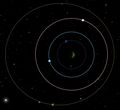Difference between revisions of "Jool"
Koloszrodos (talk | contribs) (→Natural Satellites) |
Koloszrodos (talk | contribs) (→Natural Satellites) |
||
| Line 56: | Line 56: | ||
* The captured asteroid [[Bop]], the smallest body orbiting Jool. Due to its distant, erratic orbit and low gravity, it is also challenging to reach. | * The captured asteroid [[Bop]], the smallest body orbiting Jool. Due to its distant, erratic orbit and low gravity, it is also challenging to reach. | ||
| − | *In 0.18, a new moon will be added, Pol, named so after a Pollen grain which it resembles. A yellowish/greenish moon, rocky and uneven with tall spiky mountains. It orbits Jool beyond Bop and is around twice as large. An image can be found [http://i.imgur.com/SshEN.png | + | *In 0.18, a new moon will be added, Pol, named so after a Pollen grain which it resembles. A yellowish/greenish moon, rocky and uneven with tall spiky mountains. It orbits Jool beyond Bop and is around twice as large. An image can be found [http://i.imgur.com/SshEN.png here]. |
Laythe, Vall, and Tylo are in a Laplace resonance, with orbital periods of 1:2:4 respectively. Despite the fact that the moons can easily eclipse both each other and Jool, they do not. | Laythe, Vall, and Tylo are in a Laplace resonance, with orbital periods of 1:2:4 respectively. Despite the fact that the moons can easily eclipse both each other and Jool, they do not. | ||
Revision as of 12:19, 29 November 2012
Jool is a gas giant and the fifth planet of the Kerbolar star system. It is the most distant of the five planets and the hardest to reach. It is one of the most appealing targets for missions, however, because of its large and complex system of four moons: Laythe, Vall, Tylo and Bop. Orbits well-aligned with the orbital plane, and many intersections with moon orbits can easily be captured by a couple moons with little to no ΔV before having to correct your orbit.
Atmosphere
|
Although Jool has a radius ten times greater than Kerbin, its atmosphere begins just twice as high (138.2 km). It is extremely dense, well suited for aerobraking from a high-speed interplanetary intercept. Orbiting just outside the atmosphere will give you a period of 94.7437 minutes, and a speed of 6,785 m/s. You typically do not need to go lower than 60 km to aerobrake. In general, the atmospheric pressure on Jool at an altitude expressed in meters is: Closer to the surface, the physics of the game start to break down. Due to its extremely thick atmosphere, terminal velocity is so low that lighter spacecraft will not even need parachutes or retrorockets. It is not impossible to land on its solid surface, though spacecraft are inevitably and invariably devoured by the Kraken. If a kerbonaut is put on EVA he will not be destroyed, making one-way sacrificial landings feasible. |
Natural Satellites
 The ocean moon Laythe, about to transit Jool. Jool has four natural satellites:
Laythe, Vall, and Tylo are in a Laplace resonance, with orbital periods of 1:2:4 respectively. Despite the fact that the moons can easily eclipse both each other and Jool, they do not. GalleryTrivia
Changes
|
||||||



